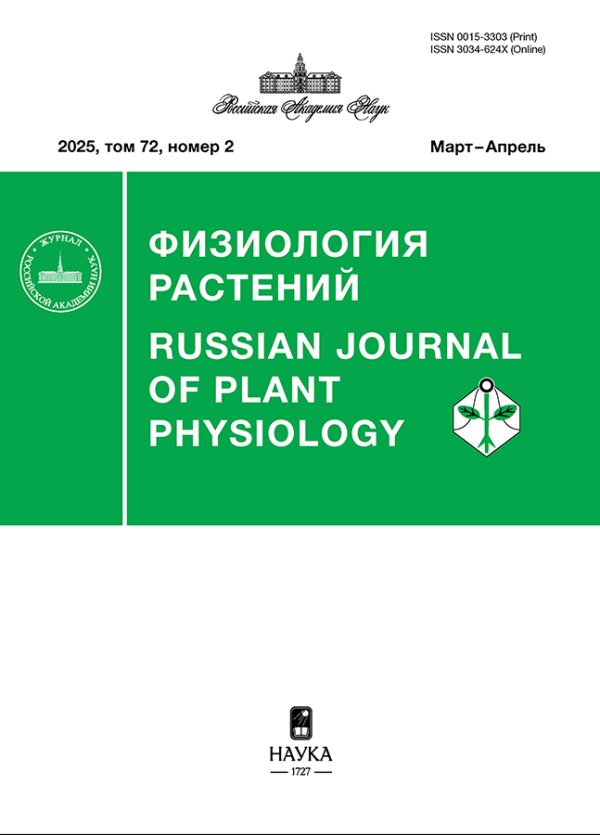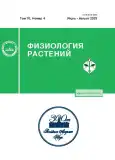Ca2+-dependent regulation of the proton permeability of the inner membrane of lupine cotyledon mitochondria
- Authors: Shugaev A.G.1, Butsanets P.A.1, Shugaeva N.A.1
-
Affiliations:
- Timiryazev Institute of Plant Physiology, Russian Academy of Sciences
- Issue: Vol 70, No 4 (2023)
- Pages: 372-381
- Section: ЭКСПЕРИМЕНТАЛЬНЫЕ СТАТЬИ
- URL: https://journals.rcsi.science/0015-3303/article/view/139778
- DOI: https://doi.org/10.31857/S0015330322600814
- EDN: https://elibrary.ru/PZENWD
- ID: 139778
Cite item
Full Text
Abstract
change in volume, and proton permeability of the inner membrane of mitochondria isolated from cotyledons of etiolated seedlings of narrow-leaved lupine (Lupinus angustifolius L.) was studied. The mitochondria used in the work were characterized by a strong coupling of oxidation and phosphorylation processes. The high functional activity of mitochondria was confirmed by their ability to generate a transmembrane gradient of protons on the inner membrane (membrane potential or ∆Ψ) during the oxidation of succinate and also sustainably maintain it for a long time , both due to the operation of the electron transport chain and due to ATP hydrolysis under conditions of anaerobiosis. It was shown that the presence of 60–120 µM CaCl2 in the mitochondrial incubation medium had no significant effect on the rate of succinate oxidation and the parameters of oxidative phosphorylation; however, it induced ∆Ψ dissipation under conditions of oxygen depletion in the incubation medium. The most complete removal Ca2+ from the medium in the presence of chelators (EGTA, EDTA) prevented the membrane potential dissipation. Ca2+-dependent depolarization of the inner membrane was inhibited by dithiothreitol, suggesting involvement in this process of reactive oxygen species. The reset of the membrane potential was not accompanied by swelling of mitochondria and was not sensitive to cyclosporine A. Using metallochromic Ca2+-indicator arsenazo III, it was shown that the mitochondria of lupine cotyledons are able to actively absorb exogenous Ca2+ and store it in the matrix. Ca2+-induced dissipation of ∆Ψ under conditions of anaerobiosis was accompanied by the release of Ca2+ from mitochondria, the rate of which sharply increased in the presence of calcium ionophore A23 (A23187). It is assumed that the accumulation of Ca2+ and an increase in the level of reactive oxygen species in the matrix induces reversible permeabilization of the inner mitochondrial membrane of lupine cotyledons under conditions of anaerobiosis, which is due to the opening of a pore of nonspecific permeability in a state of low conductivity permeable to protons and, possibly, to other small cations (Na+, K+, Ca2+).
About the authors
A. G. Shugaev
Timiryazev Institute of Plant Physiology, Russian Academy of Sciences
Email: fizrast@mail.ru
Russian Federation, Moscow
P. A. Butsanets
Timiryazev Institute of Plant Physiology, Russian Academy of Sciences
Email: fizrast@mail.ru
Russian Federation, Moscow
N. A. Shugaeva
Timiryazev Institute of Plant Physiology, Russian Academy of Sciences
Author for correspondence.
Email: fizrast@mail.ru
Russian Federation, Moscow
References
- Azzolin L., von Stockum S., Basso E., Petronilli V., Forte M.A., Bernardi P. The mitochondrial permeability transition from yeast to mammals // FEBS Lett. 2010. V. 584. P. 2504. https://doi.org/10.1016/j.febslet.2010.04.023
- Bernardi P., Rasola A., Forte M., Lippe G. The mitochondrial permeability transition pore: channel formation by F-ATP synthase, integration in signal transduction, and role in pathophysiology // Physiol. Rev. 2015. V. 95. P. 111. https://doi.org/10.1152/physrev.00001.2015
- Vercesi A., Castilho R.F., Kowaltowski A., de Oliveira H.C.F., de Souza-Pinto N.C., Figuella T.R., Busanello E.N.B. Mitochondrial calcium transport and the redox nature of the calcium-induced membrane permeability transition // Free Radical Biol. Med. 2018. V. 129. P. 1. https://doi.org/10.1016/j.freeradbiolmed.2018.08.034
- Ichas F., Mazat J.-P. From calcium signaling to cell death: two conformations for the mitochondrial permeability transition pore. Switching from low- to high-conductance state // Biochim. Biophys. Acta. 1998. V. 1366. P. 33.
- Sileikyte J., Forte M. The mitochondrial permeability transition in mitochondrial disorders // Oxidative medicine and cellular longevity. 2019. art. ID 3403075. https://doi.org/10.1155/2019/3403075
- Tajeddine N. How do reactive oxygen species and calcium trigger mitochondrial membrane permeabilisation? // Biochim. Biophys. Acta. 2016. V. 1860. P. 1079. https://doi.org/10.1016/j.bbagen.2016.02.013
- Zancani M., Casolo V., Petrussa E., Peresson C., Patui S., Bertolini A., De Col V., Braidot E., Boscuttiand F., Vianello A. The permeability transition in plant mitochondria: the missing link // Front.Plant Sci. 2015. V. 6. Art. 1120. https://doi.org/10.3389/fpls.2015.01120
- Fortes F., Castilho R.F., Catisti R., Carnieri E., Vercesi A.E. Ca2+ induces a cyclosporin A-insensitive permeability transition pore in isolated potato tuber mitochondria mediated by reactive oxygen species // J. Bioenerg. Biomembr. 2001. V. 33. P. 43. https://doi.org/10.1023/A:1005672623709
- Arpagaus S., Rawyler A., Braendle R. Occurrence and characteristics of the mitochondrial permeability transition in plants // J. Biol. Chem. 2002. V. 277. P. 1780. https://doi.org/10.1074/jbc.M109416200
- Virolainen E., Blokhina О., Fagersted K. Ca2+-induced high amplitude swelling and cytochrome c release from wheat (Triticum aestivum L.) mitochondria under anoxic stress // Ann. Bot. 2002. V. 90. P. 509. https://doi:101093/aob/mcf221
- Martins I.S., Vercesi A.E. Some characteristics of Ca2+ transport in plant mitochondria // Biochem. Biophys. Res. Commun. 1985. V. 129. P. 943. https://doi.org/10.1016/0006-291X(85)91982-5
- De Col V., Petrussa E., Casolo V., Braidot E., Lippe G., Filippo A., Peresson C., Bertolini A., Giorgio V., Checcgttto V., Vianello A., Bernardi P., Zancani M. Properties of the permeability transition of pea steam mitochondria // Front. Physiol. 2018. V. 9. P. 1626. https://doi.org/10.3389/fphys.2018.01626
- Petrussa E., Casolo V., Peresson C., Braidot E., Vianello A., Macri F. The K+ ATP channel is involved in a low-amplitude permeability transition in plant mitochondria // Mitochondrion. 2004. V. 3. P. 297. https://doi.org/10.1016/j.mito.2004.01.002
- Шугаев А.Г., Буцанец П.А., Шугаева Н.А. Салициловая кислота индуцирует протонную проницаемость внутренней мембраны митохондрий семядолей люпина // Физиология растений. 2016. Т. 63. С. 765. https://doi.org/10.7868/S0015330316060099
- Буцанец П.А., Шугаева Н.А., Шугаев А.Г. Влияние мелатонина и салициловой кислоты на генерацию АФК митохондриями семядолей люпина // Физиология растений. 2021. Т. 68. С. 421. https://doi.org/10.31857/S0015330321040035
- Шугаев А.Г., Буцанец П.А., Андреев И.М., Шугаева Н.А. Влияние салициловой кислоты на метаболическую активность митохондрий растений // Физиология растений. 2014. Т. 61. С. 555. https://doi.org/10.7868/S0015330314040186
- Chance B., Williams G.R. The respiratory chain and oxidative phosphorylation // Adv. Enzymol. 1956. V. 17. P. 65.
- Bredford M.M. A rapid and sensitive method the quantitation of microgram quatities of protein utilizing the principle of protein-die binding // Anal. Biochem. 1976. V. 72. P. 248. https://doi.org/10.1016/0003-2697(76)90527-3
- Moore A.L., Bonner W.D. Measurements of membrane potentials in plant mitochondria with the safranine method // Plant Physiol. 1982. V. 70. P. 415. https://doi.org/10.1104/pp.70.5.1271
- Scarpa A. Measurements of cation transport with metallochromic indicators // Met. Enzymol. 1979. V. 56. P. 301. https://doi.org/10.1016/0076-6879(79)56030-3
- Silva M.A.P., Carnieri E.G.S., Vercesi A. Calcium transport by corn mitochondria // Plant Physiol. 1992. V. 98. P. 452. https://doi.org/10.1104/pp.98.2.452
- Curtis M.J., Wolpert T.J. The oat mitochondrial permeability transition and its implication in victorin binding and induced cell death // Plant J. 2002. V. 23. P. 295. http://doi.org/101046/j.0960-7412.2001.01213.x
- Deryabina Y.I., Bazhenova E.N., Saris N.-E.L., Zvyagilskaya R.A. Ca2+ efflux in mitochondria from the yeast Endomyces magnusii // J. Biol. Chem. 2001. V. 276. P. 47801. https://doi.org/10.1074/jbc.M103685200
- Wagner S., De Bortoli S., Schwarzlander M., Szabo I. Regulation of mitochondrial calcium in plants versus animals // J. Exp. Bot. 2016. V. 67. P. 3809. https://doi.org/10.1093/jxb/erw100
- Akerman K.E.G., Moore A.L. Phosphate dependent, ruthenium red insensitive Ca2+ uptake in mung bean mitochondria // Biochem. Biophys. Res. Commun. 1983. V. 114. P. 1176. https://doi.org/10.1016/0006-291x(83)90686-1
- Blokhina O.B., Chirkova T.V., Fagerstedt K.V. Anoxic stress leads to hydrogen peroxide formation in plant cells // J. Exp. Bot. 2001. V. 52. P. 1179. https://doi.org/10.1093/jexbot/52.359.1179
- Chavez E., Melendes E., Zazueta C., Reyes-Vivas H., Perales S.G. Membrane permeability transition as induced by dysfunction of the electron transport chain // Biochem. Mol. Biol. Int. 1997. V. 41. P. 961. https://doi.org/10.1080/15216549700202021
- Bernardi P. The mitochondrial permeability transition pore: a mystery solved? // Front. Fhysiol. 2013. V. 4. Art. 95. https://doi.org/10.3389/fphys.2013.00095
- Bernardi P., Petronilli V. The permeability transition pore as a mitochondrial calcium release channel: a critical appraisal // J. Bioenerg. Biomembr. 1996. V. 28. P. 131. https://doi.org/10.1007/BF02110643
- Huser J., Blatter L. Fluctuation in mitochondrial membrane potential caused by repetitive gating of the permeability transition pore // Biochem J. 1999. V. 343. P. 311. https://doi.org/10.1042/bj3430311
- De Marchi E., Bonora M., Giorgi C., Pinton P. The mitochondrial permeability transition pore is a dispensable element for mitochondrial calcium efflux // Cell Calcium. 2014. V. 56. P. 1. https://doi.org/10.1016/j.ceca.2014.03.004
Supplementary files













